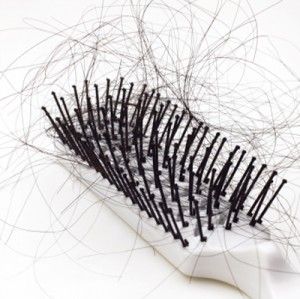____________________________
you might also want to read about
hair porosity
____________________________
PROTEIN OVERLOAD is characterized by dry and hard hair. When moisturizing and conditioning, your hair will feel very soft and moist. It will take a while for your hair to dry, but once it dries it becomes very hard. In my experience, the outer cuticle layer is what felt dry and hard, but the inner layer still felt somewhat moisturized. With breakage, the hair snaps rather then stretches out, due to the small amounts of elasticity in the hair. A good way to tell the amount of elasticity in your hair is by doing the elasticity test. This is when you wet a broken hair strand, tie each end around your index fingers, and slowly stretch the strand and observe how it snaps. ( Does it stretch 50 percent and snap? Or does it just snap right away? ) The hair also gets harder to detangle because the strands tend to stick to each other. It's caused when too much protein in their hair. Once your hair health is stable, completely avoiding protein products forever isn't the answer. Just remember protein treatments are something you only really have to do when you notice you hair is getting too soft or when you notice extra breakage.
MOISTURE OVERLOAD is characterized by very moist hair that stretches too much, resulting in breakage. The hair will feel too soft and mushy. Evaluating this is the easiest because it's symptoms is not like the other hair issues. Also, moisture overload is suppose to be very easy to fix, needing only one or two protein treatments to correct. It's caused when someone is doing too much conditioning to their hair without using protein to balance it.
LOW POROSITY is associated with smooth cuticles that shine, but where water can not enter easily. Depending how much water the strands absorbed determines how long it'll take for the hair to dry. When water is absorbed properly the hair will take a long time to dry. If water isn't absorbed properly the hair will dry fast. And when moisturizing the hair, product has a hard time entering, usually resulting in cream laying on the strands. Hair can naturally be low porosity or low porosity can be obtained from using ph correcting products too often. This one doesn't mean your hair is un-healthy, it means you have to adjust your practices to accommodate for your hair condition.
HIGH POROSITY acts like a sponge. moisture can easily enter, but easily exits. When the hair dries it dries, and quickly. Hair cuticles will feel dry and also feel rigid, not smooth. A good way to figure out porosity is to do the porosity test ( see how long a strand of your hair floats in water, see link above for details). Hair that is very high porosity is usually malnourished. High porosity hair is the natural structure of her that has been chemically treated. How much the cuticle's 'scales' have lifted depends on how high on the ph scale the chemical used is. Relaxers are probably the highest, being made from a chemical with a ph of 14. Regular use of ph correcting products must be used to combat this.
MY EXPERIENCE
When I first began experiencing protein overload, I thought I was suffering from low porosity symptoms from using Roux Porosity too often, so I stopped using it. I also did the porosity test, which told me my hair's porosity was low. I began changing my regimen in order to combat this. I was clarifying with baking soda to lift my hair cuticles, over moisturizing my hair with baggying and steaming to try to force the moisture in, and avoiding my protein products. For a while my hair felt like it was slowly getting better, but then that stopped and it was getting worse again! I did another porosity test and my hair had gone from low porosity to high porosity! But why was my hair still suffering and acting strange? That's when I realized I had protein overload. That explained why my hair had little elasticity. ^ ^'The reason my changed regimen was kinda working for me was because I was doing more clarifying, deep conditioning, and avoiding protein ingredients. Things that combat protein overload. From this I also realized that many moisturizing products have some protein ingredients in them. When you have protein overload you want products with no protein at all. This was probably why my hair was still started getting worse.





2 comments:
Thanks for this article, very interesting :))
Can you list some protein free products for us?
Post a Comment